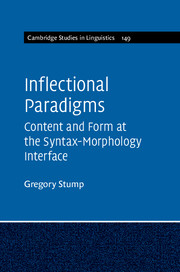Book contents
- Frontmatter
- Dedication
- Contents
- List of figures
- List of tables
- Acknowledgements
- List of abbreviations
- List of symbols and operators
- Introduction
- 1 What are inflectional paradigms?
- 2 Canonical inflectional paradigms
- 3 Morphosyntactic properties
- 4 Lexemes
- 5 Stems
- 6 Inflection classes
- 7 A conception of the relation of content to form in inflectional paradigms
- 8 Morphomic properties
- 9 Too many cells, too few cells
- 10 Syncretism
- 11 Suppletion and heteroclisis
- 12 Deponency and metaconjugation
- 13 Polyfunctionality
- 14 A theoretical synopsis and two further issues
- References
- Index
9 - Too many cells, too few cells
Published online by Cambridge University Press: 18 December 2015
- Frontmatter
- Dedication
- Contents
- List of figures
- List of tables
- Acknowledgements
- List of abbreviations
- List of symbols and operators
- Introduction
- 1 What are inflectional paradigms?
- 2 Canonical inflectional paradigms
- 3 Morphosyntactic properties
- 4 Lexemes
- 5 Stems
- 6 Inflection classes
- 7 A conception of the relation of content to form in inflectional paradigms
- 8 Morphomic properties
- 9 Too many cells, too few cells
- 10 Syncretism
- 11 Suppletion and heteroclisis
- 12 Deponency and metaconjugation
- 13 Polyfunctionality
- 14 A theoretical synopsis and two further issues
- References
- Index
Summary
In the canonical case, paradigms exhibit a kind of symmetry in two dimensions. On one hand, there is a one-to-one correspondence between the cells in a lexeme's content paradigm and the cells in the form paradigm with which it shares its realizations. On the other hand, different lexemes in the same syntactic category have content paradigms that have the same number of cells. But there are deviations from these canonical symmetries. An exceptional lexeme may have a content paradigm with more or fewer cells than the content paradigms of other lexemes belonging to the same syntactic category; moreover, a form paradigm may have more or fewer cells than the content paradigm that it realizes, and this may be true not merely exceptionally, but as a general pattern for the paradigms of lexemes belonging to a particular syntactic category. In this chapter, I examine such departures from canonical symmetry. Overabundance is a surfeit of form cells or of realized cells in comparison with the content cells that they realize; this can arise in more than one way (Section 9.1). Where overabundance involves word forms that are identical in content and consequently freely interchangeable, shape alternants are word forms that, despite the identity of the content that they express, are restricted to complementary phonological or syntactic environments (Section 9.2). Overdifferentiation is a surplus of cells in the content paradigm of an exceptional lexeme (Section 9.3). Defectiveness is an exceptional shortage of cells; such shortages arise in both content paradigms and form paradigms, though for different reasons (Section 9.4). A content paradigm may also be realized by a form paradigm with fewer cells as a consequence of syncretism, discussion of which I defer to Chapter 10.
Overabundance
Canonically, a content cell has a single form correspondent; but there are noncanonical cases in which one content cell has more than one form correspondent. Consider, for example, the lexemes seem and mean in Table 9.1. The lexeme seem inflects as an ordinary weak verb; mean, by contrast, belongs to what might be called the “T conjugation,” whose past tense is marked by a -t suffix (rather than by -d) as well as by a laxing and lowering of its stem vowel.
- Type
- Chapter
- Information
- Inflectional ParadigmsContent and Form at the Syntax-Morphology Interface, pp. 147 - 169Publisher: Cambridge University PressPrint publication year: 2015



